
As a sustainable warrior one of my main goals is to reduce my waste as much as I can, that lead me to composting and learning all the different ways of achieving it. Therefore, a composting type that really caught my eye was composting toilets. One of the first things I hear when talking about this is: What is a composting Toilet? In this article I will explain how you can reduce waste just by having one of these toilets at either your tiny house, home, or van and answer the most commonly asked questions. Everything you need to know about Composting Toilet is right here!
A composting toilet AKA dry or biological toilet is system of decomposing human feces without relying on water into a material compound made mainly of nitrogen that is similar to humus. As these toilets do not use water, they are significantly cheap in comparison to regular sewage treated toilets. Composting toilets are getting mainstream around rural or water- limited areas because they are a great tool for turning waste into a nutrient-filled substance. People are slowly getting more aware about sustainability and these kinds of toilets are just a great idea. Even though urban use is a little bit restricted because of the amount of space needed or health regulations they are getting popular.

In simply words, while regular sewage treatment uses water and discharges waste into a septic tank, composting toilets do not use water or create wastewater discharge. These sustainable toilets biologically process waste on the spot, turning it into a soil enrichment material. The usage of these kind of toilets are proven to reduce waste by thirty per cent of the original volume.
There are different types of composting toilets, some of them you could probably do it yourself or just buy one. It will all depend on how much space we have and how much waste we produce. As you can imagine, it won´t be the same requirement for a family of six than for a couple. The most important goal is to provide aerobic-safe conditions for the bacteria to be allowed to decompose the waste properly. Now, the easiest composting toilet could be made from a bucket, wood, and hay. Other options for self-contained units includes electrically powered chambers, mechanical stirrers, and heating conditions to remove the excess of humidity. Some systems will also allow regular composting ingredients such as food scraps.
One thing to have in mind if you are building up or choosing a composting toilet is a way of easily remove your finished compost. A professionally design composting system will not incur in disgusting odors because of its ventilation system. You can also add ashes and soda lime to your wastage to turn it a little bit more alkaline regarding the objective of your compost.
The most concerning question about composting toilets is of course about the smell. Nobody wants their home, whether if that is a van, a boat, a tiny home or just a house, smelly. If your composting toilet is properly designed, it won´t create disgusting smell in your house. This is because of the ventilation system that will push the odors out from your home. And it will also help the bacteria break down the waste faster.
Just as I mentioned before, composting toilets are great for tiny spaces such as vans or tiny houses, they can also be used in regular homes, but urban areas might have health restrictions. Therefore, you might need to check your local laws in order to put a composting toilet at your place. There are mobile composting toilets available that will suit for example, a boat or a campervan. These toilets will be design specially to avoid leaking or spilling when moving your house around.
Yes! Composting toilets can decompose both pee and poop. There might be different storage areas on the compost container as it is important to keep humidity away from feces so it can decompose properly. Solid and liquid waste should always be kept separate because the mixture of both will result in a stinky compost, and that is exactly what you want to avoid. Most of composting toilets will have a flap for the solid and some holes for liquid waste and they will be stored separate. While solid will decompose, you can use liquid to water your plants. No, that won´t hurt them!
All composting toilets need a ventilation system to allow the bacteria to decompose matter. This can be done either by air tubes or fans. Fans would be exactly as the ones used to cool computers, and it will push the air (and odors) out. It would be useful to have an electric fan to do this at all times as it will help the composting process. If you know that you are not going to use the toilet for a couple of days or weeks you can easily unplug it but you need to remember to turn the compost around every now and then.

Once your bucket has filled up you can either take it into an outside composting bin or just chop it out. This will depend on what your main purpose for a composting toilet is. In an outdoor composting bin, you can use it as green matter and keep it for extra decompose.
This is one of the most popular questions regarding composting toilets. If your toilet is professionally set, you shouldn´t have any problems with smell or bugs because of the odorless system. Sometimes flies can go into the toilet and if your fan is not on, they might leave larvae’s there, this is why we always need to leave the fan on!
The most important things to keep in mind when you have a composting toilet are:
If your compost is getting extremely dry because of hard feces, the best solution is to add just a little bit of water to it before turning it around. But just a little! Because the other main problem that might arise if an excess of moisture in your compost and this is exactly what you need to avoid. It preferably to have a draught compost than an overly moisturized one.
Toilets are suitable for any kind of climate, but sometimes really cold weather can freeze the liquid section, and this will be a problem. A frozen urine compartment can damage the toilet system and might make it useless. So, keep an eye on that if you live in extreme cold weather.

No, there are two different kinds of toilets that will suit different needs and work in two different ways.